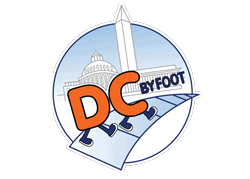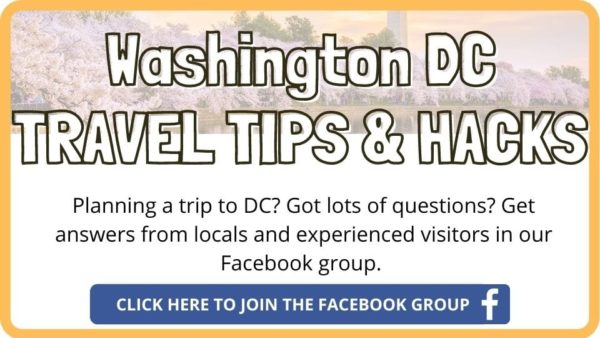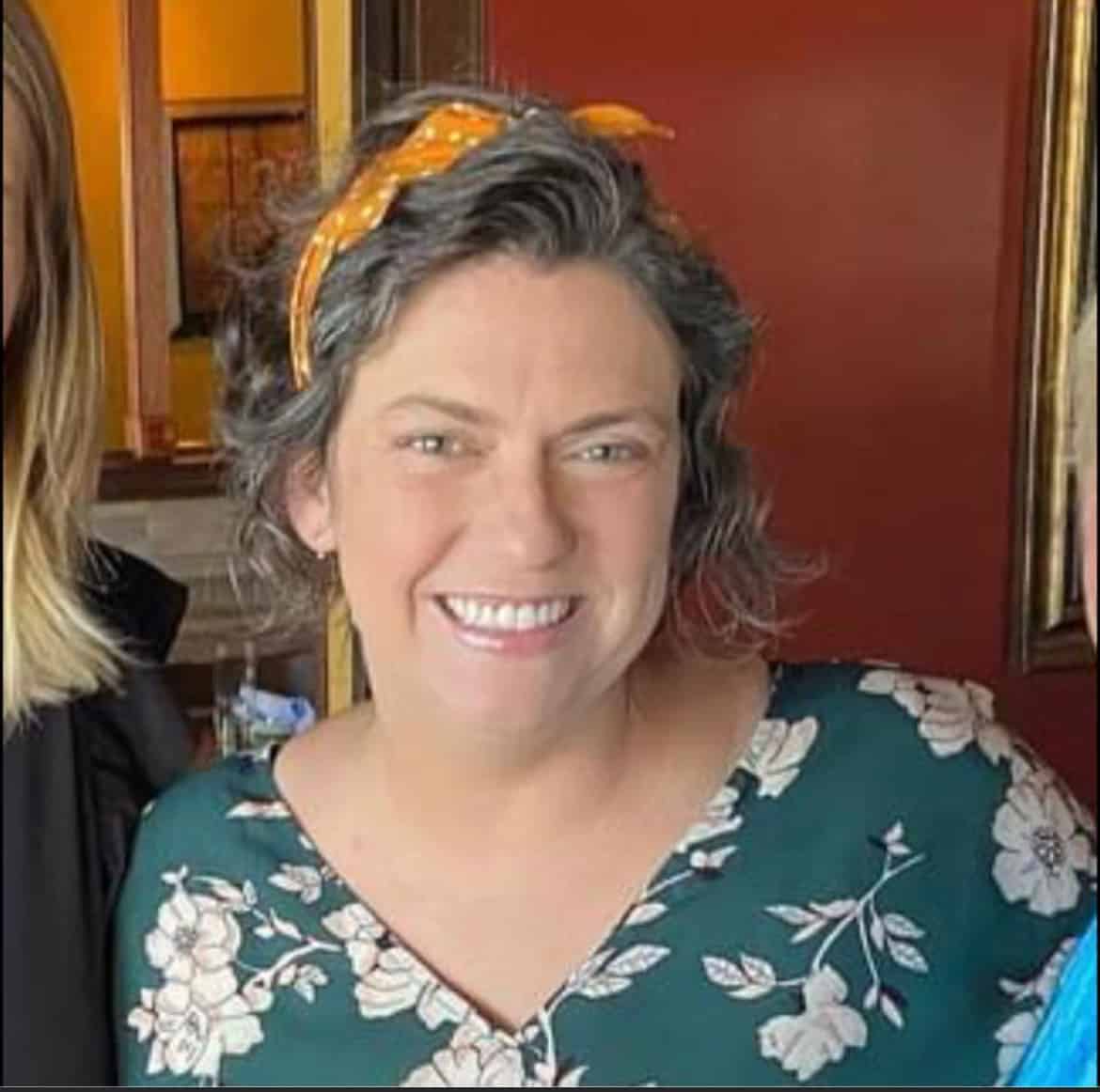The Library of Congress Building on Capitol Hill is one of Washington, DC's best architectural treasures and a must-visit for all.
Better still, it's free to enter, whether you are using the library for research or a visiting tourist.
And, as local tour guides who regularly lead tours here, we are lucky to have jobs with some of the best office space in the world.
A few of us have researched here, and one of our guides even worked here.
And, as tour guides, we are asked daily about how to visit, when is the best time, etc.
It's also a regular topic of discussion in our Washington, DC Travel Tips Facebook group, where our tour guides answer your questions about Washington, DC.
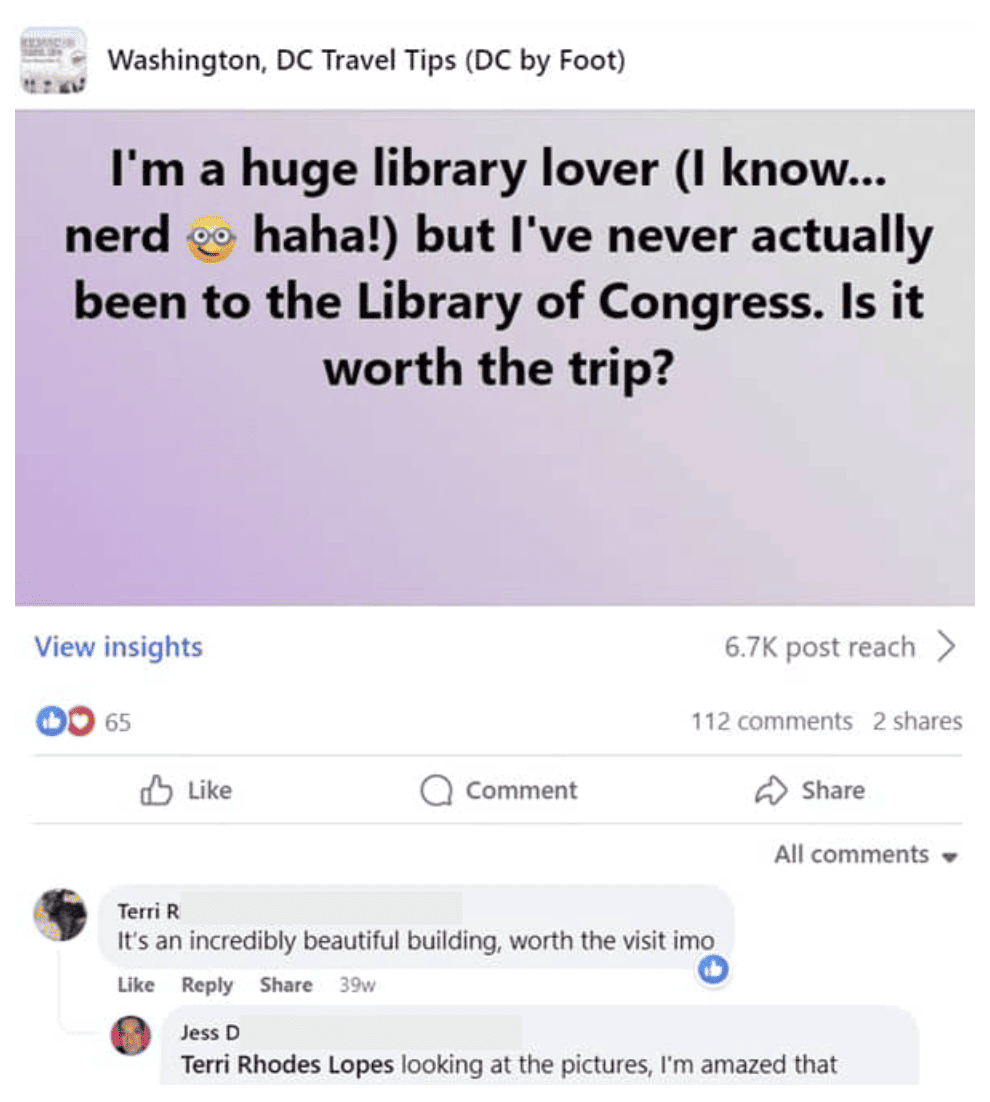
So, we decided to use our personal experiences and expertise to create to answer as many of your questions as possible.
This post explains how to take a Library of Congress tour as well as highlights and exhibits that you will see.
Be sure to join us on one of our Capitol Hill & Library of Congress Tours.
- Timed Tickets
- Plan Your Visit
- Guided Tours
- Self-Guided Tour
- Current Exhibitions
- How to Get a Library Card
- Things to Do in DC
TIMED TICKETS
As of 2023, the Library requires timed tickets in order to visit inside.
Admission to the Library of Congress is still free, but you will need to make reservations before arriving.
This process takes about 5 minutes and they usually have more than enough spots open each day.
Tickets can be reserved up to 30 days in advance, so you have plenty of time to plan out your trip.
That said, even visitors making plans the night before should have few if any issues. If you find the date you want is full, same day tickets are released at 9am the day of online.
Even if you forgot to reserve tickets, you can always take the Capitol & Library of Congress Tour, which runs twice a day, Tuesday through Saturday
We talk about and see the of the Library of Congress, as well as the Supreme Court and US Capitol.
Searching Availability...
PLAN YOUR VISIT
The Library of Congress is home to over 158 million items including books, manuscripts, maps, photographs, films, and more.
Today, the complex has multiple buildings but the most breathtaking is the original: the Thomas Jefferson Building.
Best Time to Visit
The Library of Congress is free to visit and open Tuesday - Saturday 10 am - 5 pm (open late on Thursdays) and is closed on Sundays, Thanksgiving, Christmas, and New Year's.
While timed tickets are required, there is not one time that is better than the others.
The Main Reading Room is open to visitors:
- 10:30 a.m. to 11:30 a.m. Tuesday-Friday
- 2 pm to 3 pm Tuesday-Friday
- Thursday evenings from 5:00 p.m. – 8:00 p.m.
Because of this unique experience, these times are often busier.
When the main reading room is not open to visitors, you can still view it via the second floor overlook.
How to Get Here
Address: 10 First Street, SE, Washington, DC 20540 (map).
We recommend using the map link to get exact directions, as there are 4 Metro lines in two stations for access to the Jefferson Building.
The closest is Capitol South (Orange/Silver/Blue), which is just a 5-minute walk. The other is Union Station (Red), which is a 15-minute walk.
Learn more about riding the Metro with our guide.
Find and reserve available parking in the area with SpotHero.
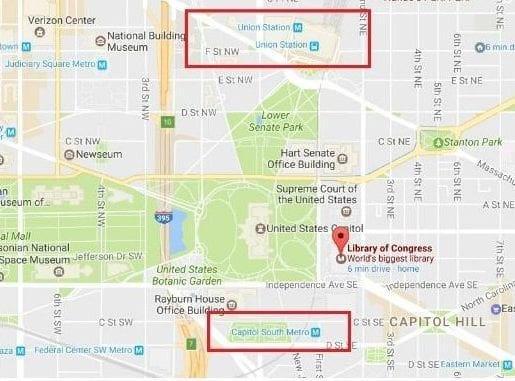
You can also access the Library of Congress and bypass security if you're already in the Capitol Visitor Center.
There is a tunnel that connects the two buildings, allowing you to go to the Library of Congress without having to go back through security.
The tunnel will bring you to the basement level of the Library, where you'll also find the Visitor Desk and the start of their guided docent-led tours.
Security
As with most buildings in D.C., expect to go through security. You can find their exact guidelines here.
There is no eating or drinking allowed in the building, though visitors are allowed to enter as long as any food or drink is stored in a bag.
Photography is allowed in most of the building, though there is no flash photography allowed in the Bibles, the Reading Room, and the Jefferson Room.
If you're visiting the U.S. Capitol Building first, you do not need to go through security again at the Library of Congress, if you take the access tunnel that connects both.
Do note that food and drink are not permitted in the Capitol.
Things to do Nearby
The Library of Congress is part of Capitol Hill, so make a half-day of it and also visit:
You're also walking distance from Union Station, where you'll find a nearby Metro Station and a food court for quick meal options.
It's a beautiful building in its own right, so take our self-guided tour of the building while you're at it.
About a 10-minute walk along Pennsylvania Ave, you'll find Eastern Market.
It is one of our favorite neighborhoods to explore local restaurants, or join our Eastern Market Food Tour!
TOURS OF THE LIBRARY OF CONGRESS
The Library of Congress offers tours of the Thomas Jefferson Building, including guided, self-guided, and virtual tours.
Take a Guided tour with us!
Our Capitol Hill & Library of Congress tour with VisitDC tours included ticketed access and a guided tour of the interior of the Library of Congress.
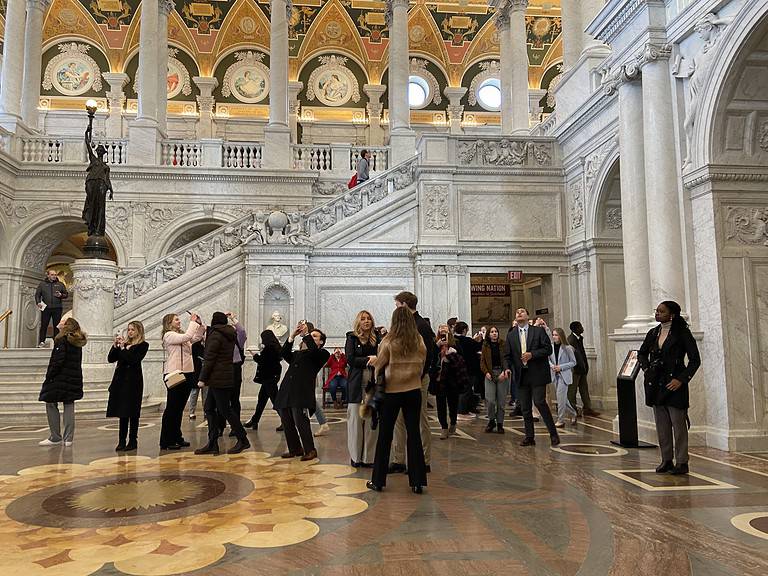
Official Guided Tours
These are the official tours that visitors enjoy on most days of the week.
This free general tour covers the art and architecture of the Jefferson Building, including a view into the main reading room, as well as the history and purpose of the library itself.
Each tour lasts 1 hour and takes place every day, except Sundays. Tours depart from the ground floor information desk.
Reserved Group Tours
The Library also offers special docent-led tours to groups of 10 or more.
These tours must be prearranged by calling the Visitor Services Office: at (202) 707-8000 or emailing them at vso@loc.gov.
The reserved group tours include:
- Thomas Jefferson: The Man and His Ideas
- Music and Performing Arts
- Exploring the Early Americas
Self-Guided and Online Tours
Below, we have provided our extensive self-guided tour of the interior and exterior of the Jefferson Building.
The library itself offers an offer an online tour, though we recommend using our self-guided tour below.
On-site, visitors can find interactive touch-screen displays that explain what is in view of the visitor.
Once you pass security, the first major room is the Great Hall. As you enter the Great Hall, you'll immediately look up.
This interior section of the building is nearly double the height of the entrance hall.
The works you see all around you are the efforts of 50 artists to contribute to the sculptures, paintings, and murals.
Scroll and zoom in to take a closer look at the Great Hall
Above you, look at the rose windows in the ceiling.
Most people assume that it is silver leaf surrounding the stained glass windows, but it is an aluminum leaf, which is more valuable at the time than silver leaf.
The various single names you see inscribed on the ceiling throughout the building are the last names of authors who have made great contributions to literature.
The first one most people spot is Bacon!
Below you are the symbols of the zodiac signs surrounding a brass inlay of the sun in the center.
Look at the staircases on either side of the Great Hall. Along the outside of each banister, you'll see "putti" which was popular during the Italian Renaissance.
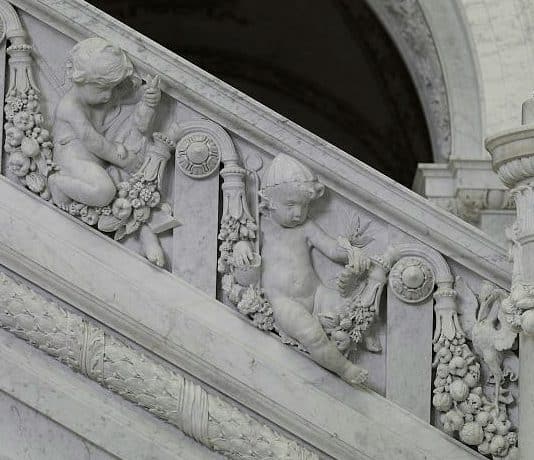
These figures each represent a different profession or hobby that was popular in American life at the time of construction.
If you look closely at these little boys, each is holding an attribute of their profession.
A mechanic holds a wrench, an artist holds a paintbrush, and an etymologist holds a butterfly net.
See if you can figure out what jobs are portrayed by looking at each of the items held by the putti.
The original idea was to put sculptures of adult men holding these symbols of professions but the proportions did not work out as well within the banister as the putti.
In the center of each banister at each side, the theme of the entire library is once again represented: the universality of knowledge.
On either side of the globe, figures represent the Americas and Africa on one side with a view of these continents on the globe they hold and a view of Europe and Asia on the opposite side of the Great Hall.
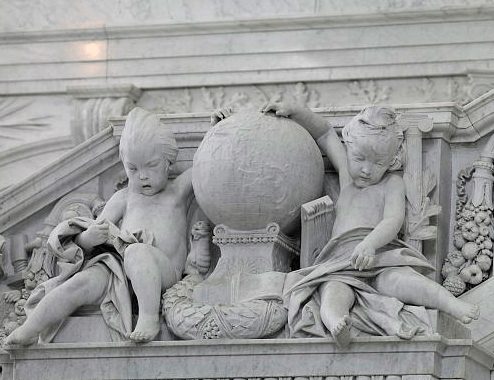
The Bible Collection
View a rare, perfect copy of the Gutenberg Bible (the first Bible printed using the printing press).
Here you can view a bible from the 1400s Germany.
See how the typeface of the printed Gutenberg Bible is similar to handwriting? They didn't have Times New Roman back then!
Once you've seen those, head upstairs to the upper level of the Great Hall.
Note the groves worn into the marble steps from more than a century of fellow travelers and researchers.
On the east side of the building, you'll see a set of steps leading up to the Main Reading Room Overlook.
The Main Reading Room
Though technically not an exhibit, this is certainly a spectacle that should not be missed during your visit to Washington, DC.
Have you seen National Treasure 2?
This is the room that hides the Presidential Book of Secrets (we can neither confirm nor deny that it is really there.)
To view the Main Reading Room, you can access the overlook from the second level of the Jefferson building.
The Main Reading Room will be open to visitors from 10:30 a.m. to 11:30 a.m. and again from 2 pm to 3 pm Tuesday-Friday.
A set of stairs in the back leads to a small walk-through so you can have a peek into this beautiful room.
The library discourages flash photography and talking in the walk-through as there are often researchers below.

During busy times, a staff member is on hand to monitor the line but otherwise, just head up the steps and stay to the right!
As you head up the stairs toward the viewing platform, you will be greeted by a large mosaic of Minerva, the Roman Goddess of Wisdom, holding a list of fields of study and accompanied by an animal we all associate with wisdom: the owl.
Inside the Main Reading Room, look up towards the dome.
The personification of Human Understanding is surrounded by twelve figures that represent the various cultures that have contributed to the universality of knowledge.
- Egypt represents Written Records.
- Judea represents Religion.
- Greece represents Philosophy.
- Rome represents Administration.
- Islam represents Physics.
- The Middle Ages represent Modern Languages.
- Italy represents Fine Arts.
- Germany represents the Art of Printing.
- Spain represents Discovery.
- England represents Literature.
- France represents Emancipation.
- America represents Science.
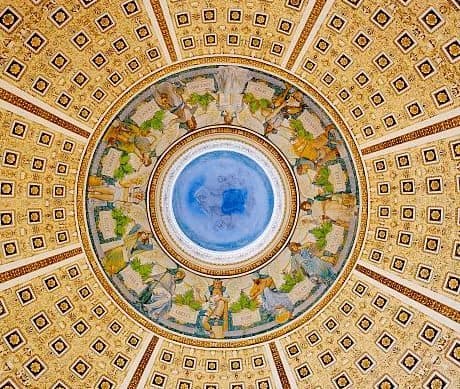
The bronze statues depict men who have contributed to:
- Religion: Saint Paul the Apostle (a leader of the first generation of Christians) and Moses (Hebrew prophet, teacher, and leader)
- Commerce: Christopher Columbus (explorer and navigator who helped open the Americas to European colonization) and Robert Fulton (American engineer and inventor known for the steam-powered engine)
- History: Edward Gibbon (author of The History of the Decline and Fall of the Roman Empire) and Herodotus (Greek author of the first great narrative history produced in the ancient world, the History of the Greco-Persian Wars)
- Art: Ludwig van Beethoven (German composer and musician between the Classical and Romantic periods. and Michelangelo (Italian Renaissance sculptor, painter, architect, and poet)
- Philosophy: Plato (Ancient Greek philosopher) and Francis Bacon (British lawyer, statesman, and philosopher)
- Poetry: William Shakespeare (English poet, dramatist, and actor) and Homer (the supposed author of the Illiad and Odyssey)
- Law: Solon (Athenian statesmen) and James Kent (helped shape common laws of both the new United States and England)
- Science: Sir Isaac Newton (English physicist and mathematician) and Joseph Henry (American scientist)
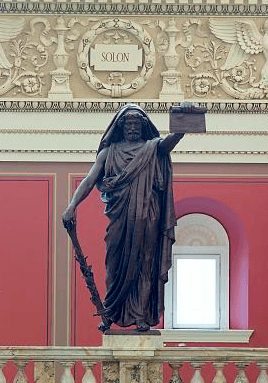
Want to see the Main Reading Room up close? A few times a year on certain holidays the Main Reading Room is open to visitors!
Exterior
The Thomas Jefferson Building, an Italian Renaissance-inspired structure, opened in 1897 to great renown.
When people visited Washington, they didn't write home about the Capitol Building or the White House, instead, they wrote home about the Library of Congress.
In many ways, the grandiosity of the building was an attempt (and a successful one) to prove America's strength in science, literature, and the arts - subjects that European countries had been dominating for hundreds of years.
For example, the building's dome, which is topped with the "Torch of Learning," is plated in 23-carat gold.
The art featured in the building is meant to showcase human achievement.
However, it also reveals the prejudice of the time, as most of the great thinkers featured throughout the building are male and Westerners.
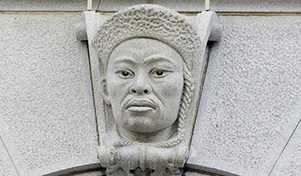
However, representing the universality of knowledge, there are also thirty-three ethnological heads, which show a wide variety of countries and cultures, that surround the exterior of the building.
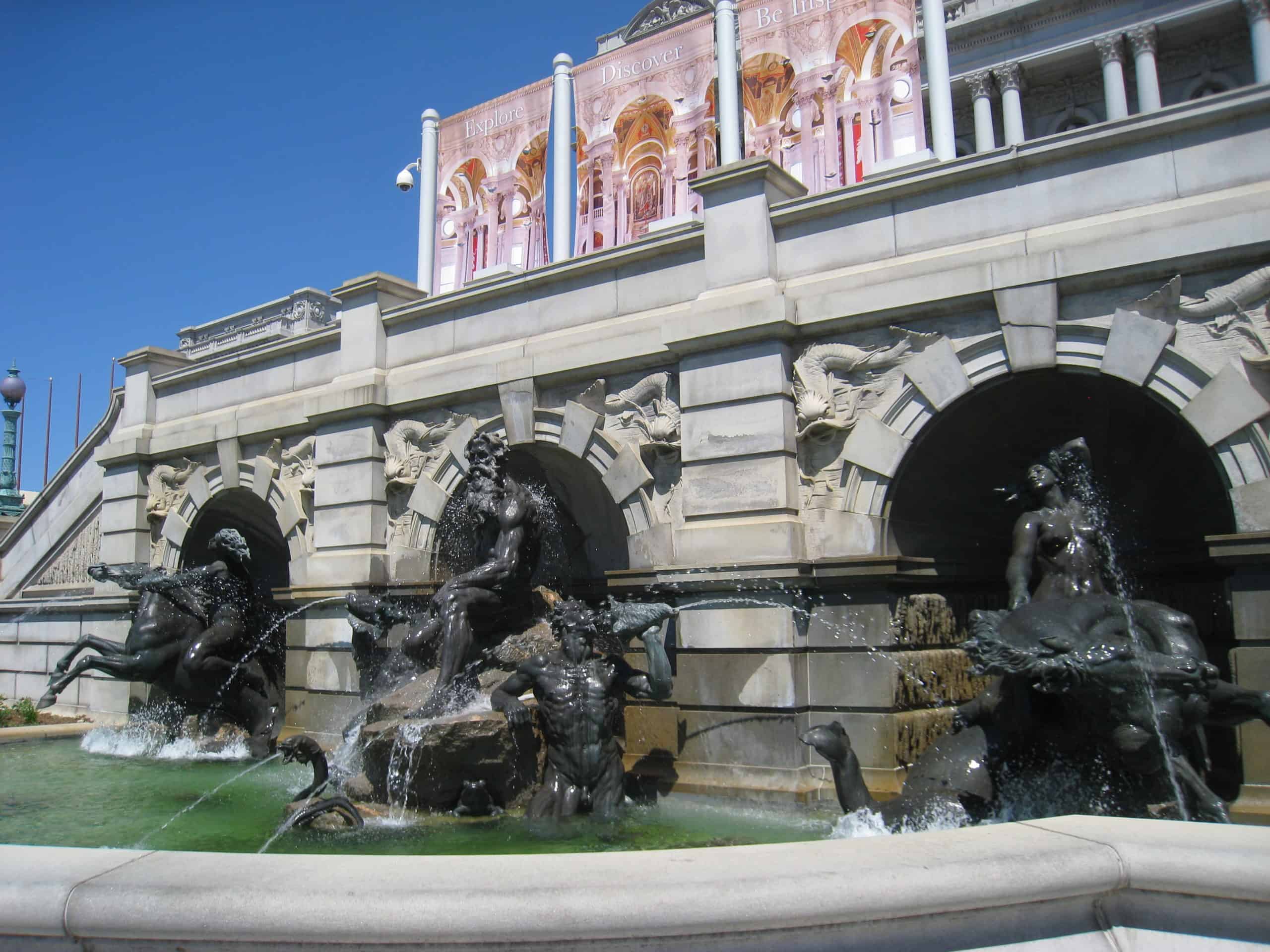
As you move to walk up the steps, take a moment to view the fountain on the road level.
This fountain of Neptune, the Roman God of the Sea. His sister, Minerva, is featured inside the building.
The king is surrounded by his court with his sons, the Tritons, and horses, symbolizing water.
He protects the sea of knowledge that is the Library of Congress' collections behind him.
The grand figure of Neptune would be 12 feet tall if he were standing!
While the fountain is not always on, the wavy lines of the sculptures do mimic the flowing of the water.
A particular favorite is the "spitting" turtles at the front of the fountain.
CURRENT EXHIBITIONS
There are permanent and rotating exhibits at the Library of Congress, and now there are also ones you can view virtually:
- Rosa Parks In Her Own Words
- Shall Not Be Denied: Women Fight for the Vote
- Comic Art: 120 Years of Panels and Pages
PERMANENT EXHIBITS
Thomas Jefferson Library Collection
On the upper level of the Great Hall, you'll find the Thomas Jefferson Collection in the south gallery.
The actual collection is in the back room so you will have to walk through one of the Library's rotating exhibits to get to it.
A must-see while visiting the Library of Congress is the collection of Thomas Jefferson.
After the Burning of Washington in 1814, the original library collection was destroyed.
Jefferson sold his 6,487 books to create a new collection but his was different - it included a Latin translation of Euclid's Geometry and a book on beekeeping.
He said that there was no topic that one day Congress might not need.
His collection is circular and you can imagine Jefferson at his desk in his swivel chair surrounded by his books.
They are organized into three categories: Memory, Reason, and Imagination, as directed by Jefferson.
He, however, arranged his books on each shelf by size.
When you're viewing the books, they are not all originals owned by Thomas Jefferson.
Nearly two-thirds were lost in another fire but the Library was able to recreate the collection. Look closely at each book and you'll see a tag sticking out of the pages on the top.
- Gold: original to Jefferson Collection
- Green: purchased by the Library, but same year and edition as Jeffersons'
- Call Number/No Tag: was already in the Library collection, but the same year and edition as Jeffersons'
- No Book: They are still looking for one! Have any 18th c. books at home?
Mapping A Growing Nation: From Independence to Statehood - North Gallery - First Floor.
Abel Buell’s New and Correct Map of the United States of North America is the first map of the newly independent United States compiled, printed, and published in America by an American. Learn more.

ROTATING EXHIBITS
Geppi Gems - Graphic Arts Galleries, Ground Floor, Thomas Jefferson Building
Highlights from the closed Geppi Entertainment Museum in Baltimore, the aim of this exhibit show how comics are a part of modern entertainment.
You'll see items including Walt Disney’s iconic characters, westerns, superheroes, science fiction, horror, sports, music, and entertainment.
Not An Ostrich: And Other Images from America's Library - Southwest Gallery, Thomas Jefferson Building
This exhibit explores photography from daguerreotypes to contemporary digital technology.
The earliest exhibit is from 1839.
From the collection of photographs at the Library of Congress, these curated pieces show you unfamiliar people and places and some offer a different view of popular events and themes.
View All Pieces from the Exhibit
HOW TO GET A LIBRARY OF CONGRESS LIBRARY CARD
Visitors can obtain a library card at the reader registration station in Room LM-140 of the Madison Building.
This building is across Independence Ave from the Jefferson Building.
You will also have to go through security to enter this building. Room LM 140 is on the ground level to the left of security.
Must be 16 years old or older, have a valid driver's license or passport, and complete a brief registration process to qualify.
HISTORY OF THE LIBRARY OF CONGRESS
Founded in 1800, the Library of Congress is the oldest federal cultural institution in the country.
When the capital officially moved from Philadelphia to Washington, D.C., President John Adams signed an act that stipulated that a library be made available to Congress and that a "suitable apartment" be created to contain it.

Thus, $5,000 was appropriated by Congress to establish the Library of Congress, which was originally housed in the Capitol Building.
However, in 1814, British troops arrived in Washington, D.C. with the intention of destroying the capital city.
The Capitol Building was burned, and all of the books in the Library of Congress were lost with it.
Shortly thereafter, retired President Thomas Jefferson offered to sell his entire collection -- over 6,000 books -- to the U.S. government to establish a new Library of Congress.
His collection caused some controversy; Jefferson's library included books in foreign languages, as well as books on philosophy, science, and mathematics.
Yet, Jefferson emphasized that "there is no subject to which a Member of Congress may not have occasion to refer."
The government eventually purchased his entire collection for $23,950.
In 1870, the size of the Library would increase dramatically as the Copyright Law was passed, requiring that all copyright applicants send 2 copies of their work to the Library of Congress.
The now rapidly growing collection required more space, and so Congress commissioned a new building, specifically dedicated for use by the Library, to be built.
